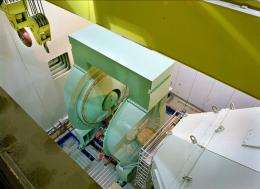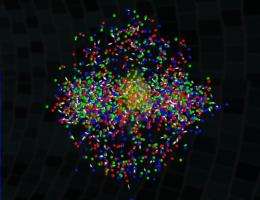Measuring material hotter than the sun

(PhysOrg.com) -- Three Vanderbilt physicists are members of the scientific team that have reported creating an exotic state of matter with a temperature of four trillion degrees Celsius. It's the hottest temperature ever achieved in a laboratory and 250,000 times hotter than the heart of the sun.
Scientists have produced this super-heated state of matter by accelerating gold nuclei to nearly the speed of light in opposite directions and then colliding them. They have done this in the Relativistic Heavy Ion Collider (RHIC) at Brookhaven National Laboratory, the largest particle accelerator in the world dedicated to nuclear physics research. The new temperature measurement has strengthened the physicists' conviction that they have managed to recreate the quark-gluon plasma (QGP), a state of matter that may have existed fractions of seconds after the Big Bang.
The three scientists are Victoria Greene, professor of physics and executive dean in the College of Arts and Science; Charles Maguire, professor of physics; and Julia Velkovska, associate professor of physics. For the last nine years, they have played a key role in the design and operation of PHENIX, the largest of the four detectors positioned around the accelerator's 2.4-mile-circumference. The new results were announced Feb. 15 at the annual meeting of the American Physical Society in New York.
"The temperature measurement was made at PHENIX by measuring the photons, the light particles, that were created with the plasma and escaped without interacting with other particles,” says Greene, who contributed to the paper reporting the result. To do this, the scientists figured out a clever way to separate the primordial photons from those coming from more mundane sources by comparing the photons produced in the collisions of the gold nuclei with those produced in simple collisions between two protons.

RHIC scientists don't know the exact temperature at which the protons and neutrons in atoms "melt” into their constituent parts, quarks and gluons. But they do think it is considerably below four trillion degrees. So the new measurement increases their confidence that the matter they are creating and studying is indeed the sought-for QGP.
Their observations of the most primordial of all primordial soups is improving scientists' understanding of the "strong force,” the force that acts within the nucleus of the atom and holds it together. Originally, they had predicted that the QGP would act like a gas, with all the particles moving independently. They were surprised to find that the quarks appear to be bound together in a way similar to the molecules in a liquid. This is forcing theoreticians back to their drawing boards.
Increased knowledge about the nature of the QGP can also improve cosmologists' understanding of the origin of the universe. For the first few microseconds after the Big Bang, cosmologists calculate that temperatures were so hot that a quark-gluon plasma should have formed. However, the universe immediately began to expand and cool. As it cooled below the melting point of protons and neutrons, these particles began forming much like rain drops condensing out of steam.
A fundamental physics principle called charge-parity (CP) symmetry holds that when energy is converted to mass or mass is converted into energy equal numbers of particles and oppositely charged antiparticles must be created or annihilated. However, if that principle were followed after the Big Bang, the universe would be essentially empty because equal numbers of matter and antimatter particles would have totally annihilated one another as they come into contact. There would be no matter left over to form stars and planets and people.
That leads to the second new result, which was obtained by the scientists working on one of the other RHIC detectors. They found evidence that CP symmetry may be broken in the plasma. Although this effect is not strong enough to explain the predominance of ordinary matter in the universe, it may provide new insights into how symmetry violations of this sort occur.
Brookhaven officials have announced that they will be upgrading RHIC over the next five years to get better measurements of the QGP's temperature, viscosity and other basic properties. Greene, Maguire and Velkovska will continue to participate in the RHIC collaboration, but they have also joined the scientific team using one of the detectors (the Compact Muon Solenoid) on the new Large Hadron Collider, the world's most powerful particle accelerator operated by the European Organization for Nuclear Research (CERN) in Switzerland. Here they hope to study the behavior of the quark-gluon plasma at even more extreme temperatures. They are in the process of creating a control room at Vanderbilt that will allow them to monitor the quality of the data and analyze the results in near real time without leaving home.
Provided by Vanderbilt University



















